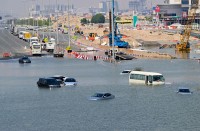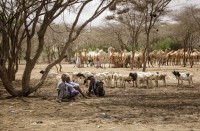QUEZON CITY, Philippines (Eagle News) — Below are two landscape photos that exudes different kinds of beauty. The first one (A) indulges you with its lush green vibe and fresh feel:

The second photo (B) gives you an urban sensation. Dazzling lights, towering skyscrapers under the night sky, a perfect scenery for an evening date in the city:
)
Now, I want you to choose which of the two pictures gave you a sudden motivation, excitement and a sense of happiness.
Take a look around your community and try to count the trees. If you saw more than fifty trees, consider yourself among the fortunate ones! Nowadays, as technological innovations follow each other at a fast-pace, we tend to spend most of our time focused on smartphones and other gadgets which make our lives a lot easier. As such, we tend to neglect our responsibility to nurture nature.
Recently, controversial news about cutting more than a thousand ‘endangered’ trees to give way for the modernization project of the government became a hot topic in the seocial media sphere.
“A total of 1,858 trees, including Narra, Molave and Ipil species which are on the endangered list, will ‘have to go’ to make way for the Metro Rail Transit (MRT) 7 project,” an officer from the Department of Environment and Natural Resources (DENR) said in an interview.
The trees are along the 23.17-kilometer stretch being prepared for the construction of the MRT 7 line between SM North Edsa and Quirino Highway in San Jose del Monte, Bulacan.
“We love the trees. We share the sentiment of the environmental groups but they have to go,” the officer added.
This is such a disheartening reality. Imagine how trees older than your ancestors were treated like garbage that can be discarded anytime and anywhere without realizing their vast contribution not just to the society but especially to us– individuals.
Needless to say, trees play a vital role in the world and to us. Did you know that a simple tree can calm and boost someone’s happiness?
In 1984, a research was conducted to see how trees can play a significant role in the wellness of patients recovering from a gall bladder surgery. Those who were given rooms overlooking a small stand of deciduous trees were being discharged almost a day sooner, on an average, than those in otherwise identical rooms whose windows faced a wall. It shows how a leafy living thing can be therapeutic to humans.
Another study conducted on 1990 to 2007 found that deaths related to cardiovascular and respiratory illnesses rose in places where trees succumbed to the insects, contributing to more than twenty thousand additional deaths during the study period.
Not only do trees help people recover from illnesses, they also protect us from natural disasters such as landslides and flash floods. Who could forget the Cherry Hills Subdivision incident in Antipolo, Rizal situated in an elevated terrain cut along the perches of the Sierra Madre Mountain? On the night of August 3, 1999, the landslide happened in just a snap which took the lives of 60 people and 378 houses buried meters deep. And the massive rock slide-debris avalanche in Ginsaugon, Leyte on February 17, 2006, that have killed hundreds of people. These are among the many disasters that show nature’s formidable, destructive force and how helpless we can be without trees.
Trees play a significant role in the mountain barrier system as they hold mountain soil together, making mountains as natural windshields that significantly lower a typhoon’s wind speed. Without trees, nothing will hold the mountain soil together, causing it to be easily dissolved, or flown out by heavy rains, resulting in landslides.
Planting trees’ is one of the easiest and most sustainable ways to positively affect the environment. Aside from the mentioned benefits, here are the other reasons why we need to encourage our community to plant m0re trees:
(Photos courtesy of Bro. Efren Torres, District of Central)
1. Trees produce oxygen, thus improving the air quality. They also store carbon which eliminates the harmful effects of fossil-fuel burning.
2. Trees planted around buildings and in the city significantly reduces air-conditioning costs, resulting to less freon, an inflammable and odorless chemical emitted from air conditioners which are considered to have damaging effects to the ozone layer.
3. Trees generate jobs and contribute raw materials for buildings, newspapers, books, etc. They are renewable, biodegradable and recyclable.
4. They provide shelter and food for wildlife such as birds, squirrels, and bugs.
5. Trees make people feel good. Workers are more productive when they see trees along their commute routes and from their office windows.
6. Landscapes that include trees help relax us, lower heart rates and reduce stress.
7. Very old trees give a source of pride for cities and towns and are often seen as historical landmarks.
8. Trees give us visual signs of seasonal change. Deciduous and broad-leaved trees have a unique form each season providing us with an ever-changing source of beauty (Source: A Healthier Michigan).
Yet do not get me wrong. I do not say that modernization is a totally bad thing. A modernized country is a symbol of its economic strength, sustainability, sovereignty and political power – all the things that a state needs. Cases in point are the cities in the Arab area, Dubai, Kuwait, Riyadh; European giants, Germany, UK, France; even our Asian neighbors, Malaysia, Singapore, China, South Korea and Japan. All these countries show political sovereignty over their lands through their modernized look and urban sanctuaries.
In the end, what’s important is that balance is sustained between modernization and ecological maintenance. If this balance is sustained, we shall reap the gifts of modernization and feel the warm embrace of nature.
(written and researched by Jodi Bustos, edited by Jay Paul Carlos)













